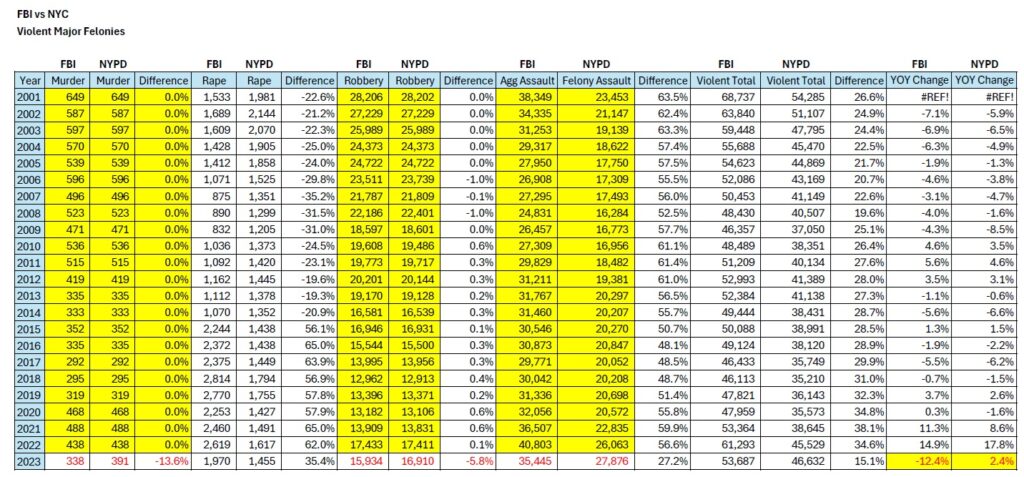Between 2001 and 2022, the FBI’s Uniform Crime Report (UCR) consistently reported higher violent crime statistics for New York City compared to the figures provided by the NYC Police Department. This discrepancy can be partly attributed to the differing definitions of crime used by the FBI and the NYPD. Although New York City employs a similar classification for major violent felonies, it adheres to the definitions set forth by the New York State Penal Law (NYSPL), which are more stringent than the criteria of the FBI’s UCR. However, a surprising shift occurred in 2023, when the FBI’s UCR figures for NYC unexpectedly fell below those reported by the city itself. This change has raised questions about the accuracy and reliability of the FBI’s crime reporting for the nation’s largest city and the country as a whole. (Click on the chart below to enlarge the image)
Analyzing the Discrepancies
From 2001 to 2022, the data showed consistent patterns:
- Murder statistics aligned perfectly between FBI and NYC reports.
- Robbery figures showed minimal differences (less than 0.06%).
- FBI reports often showed higher numbers for rape and aggravated assault, likely due to broader definitions within the agency’s reporting system.
- Despite the differences in rape and felony assault definitions, the overall violent crime trends reported by the FBI and NYC were consistent.
The 2023 data, however, revealed significant departures from these established trends:
- Murders: FBI reported 338, while NYPD reported 391 (13.6% understatement by FBI)
- Robberies: FBI reported 15,938, compared to NYPD’s 16,910 (5.8% fewer reported by FBI)
- Overall violent crimes: FBI reported 53,687, down 12.4% from the previous year
In stark contrast, New York City’s own data indicated a 2.4% increase in violent crimes for 2023. This discrepancy suggests that the FBI’s data failed to account for approximately 9,000 violent crimes in New York City that year.
Implications for National Crime Statistics
The inconsistencies observed in New York City’s data raise concerns about the accuracy of the FBI’s broader crime reporting.
Consider these points:
- According to the FBI, cities with populations over 1 million totaled 22,156,466 residents.
- The FBI reported a 10.6% decrease in violent crime for these large cities in 2023.
- New York City, with a population of 8,236,567, represents 37% of this group.
Given the estimated undercount of 9,000 violent crimes in New York City alone, the reported decline in violent crime across major U.S. cities is called into question. The significant population weight of New York City in this dataset amplifies the potential impact of these reporting discrepancies on national crime statistics.
Conclusion
The unexpected reversal in reporting patterns and the substantial discrepancies between FBI and NYPD data for 2023 highlight the need for a thorough examination of crime reporting methodologies. As crime statistics play a crucial role in shaping public policy and resource allocation, ensuring their accuracy is paramount. Further investigation into these discrepancies is necessary to maintain public trust in crime reporting and to ensure that crime prevention strategies are based on reliable data.
Written by,
Sam Antar
© Copyright by Sam Antar. All rights reserved.
